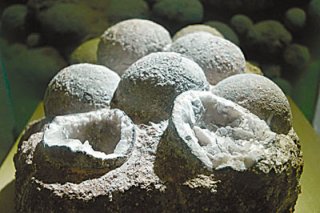Eating lots in springtime is crucial.
That's when protein in plants is more available and easier to digest.
那時(shí)的植物含有更多的蛋白質(zhì)且更易于吸收。
Calcium is not very abundant in a lot of plants, and so you have to eat a lot.
大部分植物的含鈣量不是很高,所以你就得吃很多。
You have to focus on high-quality foods, high-quality plants...
你必須要專吃那些高質(zhì)量的食物高質(zhì)量的植物,
the buds, the shoots, the young leaves...to try to get those minerals, those nutrients to build the babies.
如嫩芽,嫩枝,嫩葉等來得到這些礦物質(zhì),這些用來孕育小恐龍的營(yíng)養(yǎng)物質(zhì)。
With Sauroposeidon's voracious appetite, tiny amounts of calcium add up.
波塞東恐龍很貪食,鈣元素在體內(nèi)積少成多。
Bit by bit, it's all stored in her bones...specifically, medullary bone.
一點(diǎn)一點(diǎn)地,儲(chǔ)存在骨頭里,確切地說,在髓骨里。
Medullary bone is very special bone that's laid down only by an ovulating female.
髓骨是一種很獨(dú)特的骨頭,只有排卵期的雌性恐龍才有。

And it's laid down to gather together calcium for calcium-carbonate eggshells that they are making during ovulation.
它儲(chǔ)存和積累鈣元素,用于形成排卵期間由碳酸鈣構(gòu)成的蛋殼。
Medullary is a layer of bone which lines the interior of leg bones. It has no structural purpose.
髓骨是排列在腿骨的內(nèi)部的一層骨頭。它沒有結(jié)構(gòu)上的用途。
Instead, it's a mobile store for calcium and other minerals required to make eggshells.
相反,這還是個(gè)移動(dòng)的儲(chǔ)存點(diǎn)來給儲(chǔ)存形成蛋殼所需要的鈣和其他礦物質(zhì)。
Once stored in medullary bone, calcium and minerals can easily be broken down and sent to where it's needed.
一旦貯存在髓骨里鈣和礦物質(zhì)很容易被分解,并且被輸送到需要它的地方。
So you're looking at the unfolding,
你觀察一下這種演變,
the unpacking of something that starts out as a single cell into an animal that's almost the size of a whale,
它由一個(gè)單細(xì)胞開始發(fā)展成一個(gè)跟鯨差不多尺寸的動(dòng)物,
and it has to come off without a hitch.
還得順利地活下來。
In Sauroposeidon, evolution has favored something else as well...
對(duì)于波塞東龍來說進(jìn)化也同樣是有利的,
the production of a tremendous number of eggs every year.
它們每年產(chǎn)出數(shù)量龐大的恐龍蛋。
And every one of those eggs takes resources.
每一枚蛋都在汲取著營(yíng)養(yǎng)。
After mating, a female Sauroposeidon is now starting to grow the eggs inside of her, and eggs are expensive.
交配過后,雌波塞東龍?bào)w內(nèi)就開始有蛋長(zhǎng)出來,這些蛋很珍貴。
They're protein and fat and calcium...calcium for the bones of the embryo, eventually, calcium for the shell of the egg.
里面有蛋白質(zhì),脂肪和鈣元素鈣元素用于胚胎骨骼的發(fā)育到最后,鈣質(zhì)是為了形成蛋殼。
A single Sauroposeidon lays hundreds of eggs each season,
每只波塞冬龍每個(gè)季節(jié)產(chǎn)好幾百個(gè)蛋,
but many are eaten before they hatch, and most hatchlings are devoured by hungry carnivores.
但是很多都在還沒孵化前就被吃了,而且孵化出來的小恐龍大多也被饑餓的食肉動(dòng)物吞食。
Tyrannosaurus Rex, on the other hand, has evolved into something entirely different.
而霸王龍已經(jīng)進(jìn)化得完全不同。
These powerful meat eaters are intelligent and well armed.
這些強(qiáng)壯的食肉動(dòng)物非常聰明并且全副武裝。
They are killers and scavengers.
它們既是殺手也是食腐動(dòng)物。
A female ready to pass on her genes is on the lookout for a male with huge jaws,
雌性霸王龍準(zhǔn)備延續(xù)后代時(shí),
a powerful grip, and a mouthful of steel-tough teeth.
會(huì)把目光放在尋找有巨大雙顎咬力驚人和鐵齒銅牙的雄性上。


